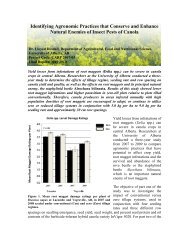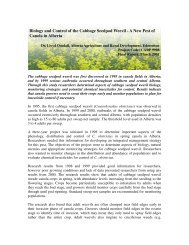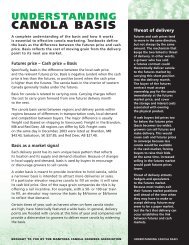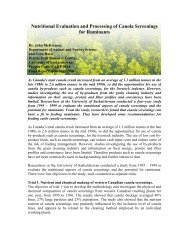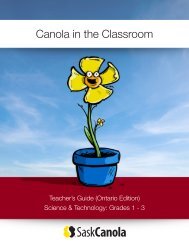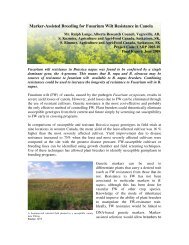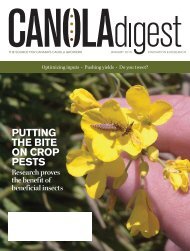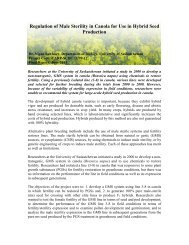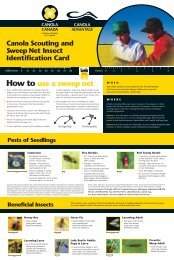Alternative Sulfur Fertilizer Sources for Canola - SaskCanola
Alternative Sulfur Fertilizer Sources for Canola - SaskCanola
Alternative Sulfur Fertilizer Sources for Canola - SaskCanola
You also want an ePaper? Increase the reach of your titles
YUMPU automatically turns print PDFs into web optimized ePapers that Google loves.
Overall, a significant increase in mid-season dry matter yield was observed in response to<br />
increasing rates of sulfur fertilizer. However, rates of sulfur above 20 kg S/ha did not<br />
result in significant increases in final grain and straw yield, but did result in increased<br />
sulfur uptake and accumulation of residual sulfate in the soil. There<strong>for</strong>e, it appears that a<br />
sulfur fertilization rate in the range of 15-25 kg S/ha would be satisfactory in ensuring<br />
adequate sulfur nutrition of the canola crop under conditions present. (Table 1) and<br />
(Table 5).<br />
In the year of application, powdered elemental sulfur alone was the least effective in<br />
increasing sulfur availability and yield of canola, and ammonium sulfate was most<br />
effective. The observed lower sulfur availability and yield response from the elemental<br />
sulfur source is due to incomplete conversion of the elemental sulfur to the plant<br />
available sulfate <strong>for</strong>m in the soil in the year of application. The waste gypsum sources<br />
per<strong>for</strong>med nearly as well as the ammonium sulfate, pointing to the possibility of using<br />
such sources of sulfur as another means to increase soil sulfur availability in the Gray soil<br />
zone. The elemental sulfur sources resulted in yield increases of approximately 0.2 T/ha<br />
compared with yield increases approaching 0.4 T/ha with the ammonium sulfate and<br />
gypsum sources. (Table 5)<br />
Overall, the waste gypsum sources evaluated in this project could be an effective means<br />
<strong>for</strong> canola producers to economically increase sulfur availability in sulfur deficient soils<br />
of the Gray soil zone. Other product possibilities include the combination of powdered<br />
elemental sulfur with lime and sewage sludge to produce a pellet or wafer of high sulfur<br />
analysis, which can be easily handled and applied, but also oxidizes relatively rapidly.<br />
Such products may be worthwhile considering <strong>for</strong> producers who desire a slow release<br />
type of sulfur source that is applied once at a high rate and then slowly released into<br />
available <strong>for</strong>ms over a number of years.<br />
Note: Scroll to page 3 to view Table 1 and page 4 to view Table 2.



